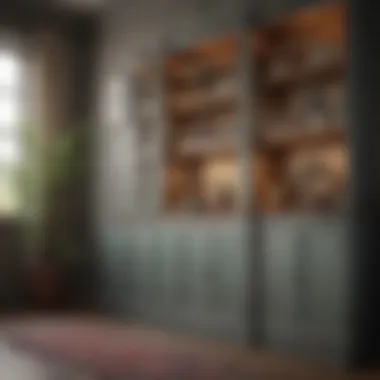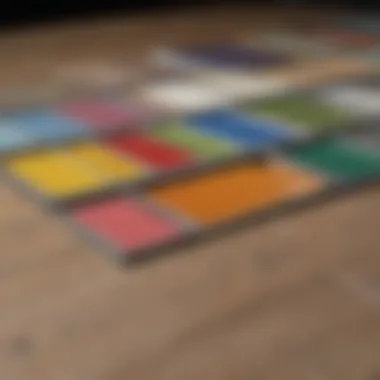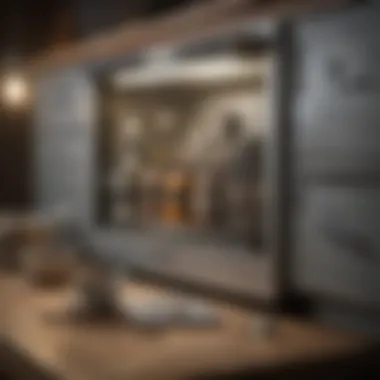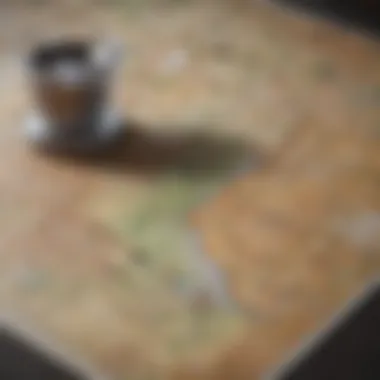Understanding the True Cost of Painted Cabinets


Intro
The primary concern for many homeowners considering a renovation project is cost. When it comes to painted cabinets, understanding what influences the total expense is crucial. This involves scrutinizing a variety of factors that contribute to the pricing, which can vary significantly based on choices made throughout the process. Whether you are embarking on a full kitchen remodel or simply updating your existing cabinetry, it is essential to be aware of not just the immediate costs, but also the long-term investments.
As painted cabinets have gained popularity, especially in modern interior design, there is a growing demand for insights into pricing structures. Homeowners and design enthusiasts both will benefit from examining these factors closely. In this article, we will break down materials, finish types, labor costs, and other geographic considerations that play a role in determining the price of painted cabinets. By the end of this exploration, readers will have a clearer vision for their projects and a better understanding of each component that contributes to the overall budget.
Key Insights and Trends
In today's interior design landscape, painted cabinets remain a favored choice for several reasons. Current trends emphasize clean lines and a cohesive aesthetic, leading to a shift towards lighter color palettes that can enhance the perception of space. Bold accent colors are also on the rise, allowing for personalized expression within kitchens and other areas of the home.
Popular Color Schemes
- Soft whites and creams to create an airy feel.
- Dark, moody colors like navy or black for dramatic contrast.
- Pastel shades for a vintage or softer touch.
As the demand evolves, the quality of paint is becoming increasingly vital. Homeowners seek durable finishes that withstand wear and tear, making the right selection essential for any renovation project. High-quality paints not only extend the life of the cabinets but also impact labor costs due to necessary preparation and application work.
"Invest in quality materials and finishes; the long-term savings can outweigh initial costs." - Home Renovation Expert
Practical Tips and How-To Guides
When planning to paint cabinets, there are several practical tips to consider. First, determine if this project will be a DIY effort or if hiring a professional is more suited to the scope of the work.
DIY vs. Professional Services
- DIY: This can save money, but it requires time, skill, and equipment.
- Professional: A skilled contractor can provide expertise, often leading to a smoother finish and potentially saving time in the long run.
Step-by-Step Painting Process
- Prepare the cabinets by removing hardware and cleaning surfaces.
- Sand the cabinet surfaces to allow better paint adhesion.
- Apply a primer designed for the material type.
- Choose and apply your preferred paint finish.
- Seal the cabinets to protect against moisture and wear.
By following these steps, one can achieve a professional look even in a DIY project. Knowledge of relevant costs and careful planning can lead to successful outcomes for painted cabinets.
Preamble to Painted Cabinets
Understanding painted cabinets is vital for homeowners and design enthusiasts. They are not just a trend; they represent a functional and aesthetic choice for home renovations. As cabinets can occupy significant space, their appearance can drastically affect the overall look of a kitchen or any other room. The decision to paint cabinets should be approached thoughtfully.
Choosing to paint cabinets opens up a variety of possibilities. Homeowners can select colors that complement their decor, influence the mood of a space, and showcase personal style. Moreover, painted cabinets can rejuvenate older furniture or enhance new installations. This renovation choice often appears simpler than it is, as various factors contribute to the final cost. Thus, grasping these elements helps create a realistic budget and expectation.
In this section, we will define what painted cabinets are and explore their growing appeal in interior design. Understanding these aspects can guide homeowners in making informed decisions that align with both aesthetic desires and budget constraints.
Defining Painted Cabinets
Painted cabinets refer to cabinetry that has been coated in paint rather than left in its natural wood state or covered with veneers. This process allows for contrast or harmony in the design. Depending on the type of finish chosen, painted cabinets can range from high-gloss modern looks to soft and muted tones. The material of the cabinet also plays a crucial role in how paint adheres and ages over time.
In the context of kitchen renovation, the term 'painted cabinets' usually pertains to kitchen cupboards and drawers. However, painted cabinetry can also include furniture pieces in other spaces, such as bathrooms or living rooms.
Why Choose Painted Cabinets?
There are several compelling reasons to consider painted cabinets. First, they are a cost-effective way to update an existing kitchen. Rather than a full renovation, repainting can provide a fresh look without major structural changes.
Another reason is the wide array of color options available. Paint allows homeowners to express creativity and customize their homes. Trends have shifted toward lighter and brighter colors in recent years, but personal preference ultimately creates the defining style.
Additionally, painted cabinets can increase resale value. Prospective buyers often appreciate the modern touch of updated accessories without the need for a complete renovation. Since kitchen upgrades tend to yield high returns on investment, selecting the right paint color and quality becomes crucial.
However, it is essential to also acknowledge drawbacks, such as maintenance and durability. The type of paint and finish you choose can affect how well the cabinets hold up over time, which is why understanding the cost factors associated becomes crucial before making a decision.
Choosing painted cabinets is both an artistic and practical decision that aligns with modern aesthetics and cost efficiency.


Cost Breakdown of Painted Cabinets
Material Costs
Material costs play a significant role in the total expenses involved in painted cabinets. The type of material chosen not only affects the upfront costs but also influences durability and aesthetics.
Solid Wood vs. MDF
Solid wood and MDF represent two common options for cabinet construction. Solid wood is valued for its strength and natural beauty. Homeowners often prefer it for its authenticity and longevity. However, solid wood tends to come with a higher price point due to the quality of the material.
MDF, or medium-density fiberboard, is often seen as a more cost-effective alternative. This composite material is engineered for uniformity and is less likely to warp compared to wood. It is ideal for achieving smooth paint finishes without noticeable grain. However, it may not offer the same ruggedness as solid wood in long-term use. That being said, MDF's affordability makes it a popular choice.
Particle Board Considerations
Particle board is another material that some homeowners consider. It is made from wood chips and adhesive, which results in lower costs. Particle board is lightweight and easy to handle, making it a sensible option for DIY projects. However, it is crucial to note that particle board has a lower durability compared to solid wood and MDF. It may be prone to damage from moisture and heavy loads, which can lead to costly repairs down the line.
Finish and Paint Options
Finish and paint options significantly influence the price of painted cabinets. Selecting the right finish affects not only the visual impact but also the durability of the surface.
Type of Paint Used
The type of paint selected is crucial. While some homeowners opt for oil-based paints for their longevity and smooth finish, others may choose water-based paints due to their low odor and quicker drying times. Each type has distinct advantages and disadvantages. For example, oil-based paints are robust but can be challenging to clean up. Water-based paints, on the other hand, have an easy cleanup process but may not hold up as long in high-traffic areas.
Finish Quality Impact on Pricing
The quality of the finish can substantially affect the overall cost. Higher-quality finishes often provide better protection against wear and tear. Additionally, they can enhance the aesthetic appeal of the cabinets, making them more visually striking. While investing in a premium finish may cost more upfront, it typically yields better long-term results. This can lead to savings on maintenance and potential repair costs in the future.
Investing in higher-quality finishes can provide significant long-term benefits despite higher initial costs.
Labor Costs Involved
The aspect of labor costs is crucial when it comes to the overall expenses associated with painted cabinets. Understanding labor costs involves deciding between two main options: undertaking a DIY project or hiring professionals. Each choice has unique implications, including both monetary and time investments. Evaluating these factors will assist homeowners and design enthusiasts in making a more informed decision.
DIY Installation
Cost of Tools and Materials
When considering a DIY installation, the cost of tools and materials must be meticulously assessed. Painting cabinets typically requires specific tools such as brushes, rollers, primer, sandpaper, and spray guns. The investment in quality tools can improve the final output, ensuring a smoother finish. However, it could lead to a higher initial cost that some may overlook. Homeowners might find an advantage in controlling these costs by borrowing tools or purchasing used options.
Unique features of tools and materials may also include the potential for reusability, especially if homeowners plan to undertake further painting projects in the future. From this perspective, it serves as a beneficial choice if the homeowner is inclined toward future renovations.
Time Investment Considerations
Time investment plays a crucial role in the DIY route. Painting cabinets is not merely a one-day task; it may take several days or even weeks, depending on the scale and detail needed. This requires commitment to planning, preparing, and executing. Proper time management is essential to avoid frustration and ensure quality work. Homeowners may enjoy flexibility with their schedules, but this can result in delays to other household tasks.
The unique feature of this investment is the opportunity to learn and develop new skills. Though it may come with a cost of time, the experience gained can be fulfilling. Nonetheless, those with busier schedules might find it less practical when compared to hiring professionals.
Hiring Professional Painters
Comparing Rates
For those looking to save time or seeking high-quality results, hiring professional painters can be a suitable option. It is important to compare rates from different service providers to find the best fit for one’s budget. Rates can significantly vary based on experience, location, and scope of the project. Thus, gathering multiple quotes is an advisable practice.
A key characteristic of comparing rates is identifying hidden costs. Sometimes, low initial quotes can exclude additional charges for preparation or cleanup. Therefore, understanding the full scope of what is included in the rate is vital. Homeowners may appreciate the ease that comes with hiring professionals since they take care of all necessary tasks and types of work that go beyond the initial paint job.
Factors Affecting Labor Fees


Multiple factors can influence labor fees for hiring professionals. Geographic location is one such factor, where urban markets tend to have higher rates than rural areas. Additionally, the complexity of the job can increase the costs. If cabinets require significant prep work or repairs prior to painting, this will likely raise labor fees.
The unique aspect of these factors is how they reflect the overall economy and demand for skilled labor. In regions with higher demand, prices may escalate. This variability means that homeowners should be prepared to budget accordingly and understand that labor fees are not just about hourly rates but reflect market conditions.
Overall, understanding labor costs—whether it be through DIY efforts or hiring professionals—ensures that homeowners can align their financial decisions effectively when investing in painted cabinets.
Geographic Influences on Costs
Understanding the geographic influences on costs is crucial when contemplating the investment in painted cabinets. This section aims to elaborate on how location can significantly impact overall expenses. Variations in urban and rural pricing often define the financial scope of home renovation projects. Additionally, regional market trends can enhance or diminish the available services and materials.
Urban vs. Rural Pricing
Urban areas typically have higher expenses associated with painted cabinets. The cost of living in cities affects not only materials but also labor fees. Because urban centers often have more competition, one might expect competitive pricing for certain services. However, the high demand for renovations can drive costs up. Likewise, in rural areas, while labor may be lower, the limited availability of specialized professionals can lead to higher prices or extended wait times.
Regional Market Trends
Market trends are a reflection of a region’s economic health and demand for home improvement services. In times of economic growth, homeowners might be more inclined to seek elaborate renovations, thus impacting pricing.
Local Demand for Services
Local demand plays a significant role in the cost of painted cabinets. A surge in renovation projects in a particular area can drive costs higher. Homeowners desiring unique or artisanal finishes may find local professionals charged significantly more due to demand. Moreover, the competitive landscape can influence pricing strategies.
Key aspects of local demand include:
- Increased wait times for services
- Higher quotes due to more attractive contract offers
Ultimately, understanding local demand helps homeowners set realistic budgets.
Material Availability Variances
Material availability can greatly impact costs related to painted cabinets. In urban centers, residents may have easier access to a variety of materials. In contrast, rural areas may experience shortages, forcing homeowners to pay a premium for shipping or to choose less expensive options.
Characteristics of material availability variances include:
- Access to specialty materials in urban areas
- Increased costs for transportation in less populated regions
Homeowners should consider these factors when calculating their total expenses. By assessing geographic influences, buyers can make more informed decisions about their cabinetry renovations.
Understanding geographic influences helps mitigate costs and enhances planning efficiency for painted cabinets.
Long-Term Financial Considerations
Long-term financial considerations are a crucial aspect when evaluating the overall cost of painted cabinets. Investing in cabinets is not merely a short-term choice. Over time, homeowners need to consider the depreciation of value, the maintenance involved, and how these cabinets influence the property's worth. Understanding this realm can provide insight into making an informed investment.
Value Added to Property
Painted cabinets can significantly increase a property's value. When potential buyers view a home, kitchens and bathrooms often hold substantial sway in their decision-making. A fresh, modern look provided by well-painted cabinets can enhance appeal. The aesthetic improvement and a potentially higher market price are directly correlated.
Additionally, custom, high-quality painted cabinetry can signify quality craftsmanship, which can be a selling point. Many buyers prefer the modernity of painted finishes over traditional wood tones, making this choice beneficial.
Durability and Maintenance Costs
Long-Term Care Needs
Long-term care needs for painted cabinets involve regular upkeep to maintain their appearance. This aspect is crucial as it affects the overall longevity of the investment. Care should include cleaning methods that do not damage the finish, as well as periodic inspections to spot any cracks or chips early.
A key characteristic of durable finishes is their ability to withstand wear and tear. Therefore, choosing high-quality paint and finishes is essential. Investing in these products may have a higher initial cost but often proves to be beneficial in the long run, reducing the frequency of refinishing and repairs.


The unique feature of long-term care needs is the balance between maintenance frequency and cabinet lifespan. If properly maintained, painted cabinets can last for many years, thus providing value and functionality that blend seamlessly into the home.
Cost of Repairs and Touch-Ups
Cost of repairs and touch-ups is another factor to consider for painted cabinets. Over time, nicks and scratches may occur due to normal use. These minor imperfections can be easily touched up, which sometimes requires only the same paint and some time.
A vital point here is the affordability of these repairs. Regular touch-ups can prolong the lifespan of the cabinets, delaying the need for complete repainting. However, it is essential to choose paint that matches the original finish to avoid mismatches, potentially complicating appearance.
The unique feature of this aspect is that it provides flexibility. Minor damage does not necessarily require complete cabinet replacement. Instead, addressing issues as they arise supports the cabinet's overall longevity without substantial expense. This reflects the importance of choosing quality materials that aid in maintaining the appearance and functionality of painted cabinets.
Environmental and Health Considerations
The choice of painted cabinets has far-reaching implications beyond just aesthetics and cost. It is essential to think about how these decisions affect the environment and our health. In recent years, there has been a growing awareness of the materials used in home renovations. This section addresses the significance of selecting paint options that prioritize environmental sustainability while considering potential health risks that can arise from certain products.
One key aspect to focus on is the composition of paint. Traditional paints often contain toxic chemicals that can pose hazards not only during application but also throughout the life of the product. As such, understanding the importance of eco-friendly paint options can significantly alter the impact painted cabinets have on your indoor environment. Choosing safe materials leads not just to a healthier home but also reduces one's ecological footprint.
Choosing Eco-Friendly Paint Options
Selecting eco-friendly paint options is crucial in the renovation process. These paints are usually manufactured with safer ingredients, which can help minimize harm to both occupants and the surroundings. By opting for products that are labeled as environmentally friendly, homeowners can feel confident that they are contributing positively to their spaces. Several brands are now offering low-impact paint choices that perform as well as their conventional counterparts.
When browsing for eco-friendly paints, look for certifications recognized by various environmental agencies. This includes labels from Green Seal or EcoLogo, which can guide homeowners to make informed choices.
Some common eco-friendly paint options include:
- Natural Paints: Made from organic materials like plant oils and natural pigments.
- Acrylic Paints: Often offer low levels of volatile organic compounds (VOCs) and are more sustainable than traditional oil-based options.
- Milk Paint: A biodegradable choice that is free from casein and is also very low in VOC.
Low-VOC and Their Importance
Low-VOC paints are another crucial consideration in the context of environmental and health factors. VOCs, or volatile organic compounds, are harmful chemicals that can evaporate into the air during and after application, contributing to indoor air pollution. This can lead to various health issues, including headaches, respiratory problems, and even long-term impacts on overall health.
Using low-VOC paints not only reduces these health risks for the inhabitants but also contributes to a more sustainable approach to home renovation. These paints provide better air quality while maintaining performance and durability. In many cases, they can be just as effective as higher VOC options without the adverse effects.
Homeowners should take the time to research and understand the various options available. Consider your own health and that of your family, as well as the encourage ongoing dialogue within communities regarding safer practices and materials in home improvement.
"Opting for low-VOC and eco-friendly paints can greatly enhance living conditions while contributing positively to environmental health."
In summary, incorporating smart environmental and health considerations into the decision-making process enhances the value and safety of painted cabinets. Prioritizing eco-friendly and low-VOC options can contribute to a healthier home and a more sustainable future.
Closure and Key Takeaways
Understanding the cost factors associated with painted cabinets is vital for anyone considering a home renovation. This article has explored various elements influencing pricing, including materials, labor, geographic location, and more. By synthesizing these components, readers can gain a clearer picture of what influences their budget.
In summary, several key factors shape costs:
- Materials: The choice between solid wood, MDF, or particle board affects both price and durability.
- Labor Costs: Deciding whether to undertake a DIY approach or hire professionals can significantly impact expenses.
- Geographic Variance: Prices can fluctuate depending on local demand and material availability.
- Finish Choices: Different paint types and the overall quality of the finish can add or reduce costs.
- Long-Term Benefits: Investing in quality materials can lead to savings in maintenance over time.
"Being informed about these cost factors empowers homeowners and design enthusiasts to make decisions that align with both aesthetic desires and budgetary constraints."
These points highlight the diverse elements contributing to the overall expenditure. It is essential to evaluate each one carefully before proceeding.
Moreover, understanding potential returns on investment, such as increased property value, should not be overlooked. For homeowners, making educated choices can lead to meaningful enhancements in their living spaces.
Summary of Cost Factors
- Material Choice: Solid wood tends to be more expensive but offers durability. MDF may appear cheaper but can have its drawbacks.
- Labor Options: Professional services come with fees that vary based on skill level. DIY may save money but requires significant time and effort.
- Geographical Influences: Urban areas usually have higher labor costs due to demand.
- Finishing Costs: Higher quality finishes often lead to increased prices initially but can reduce maintenance needs.
Informed Decision Making
Informed decision-making relies on an understanding of each cost component discussed in this article. Homeowners should carefully assess their priorities and budget.
- Research Local Trends: Awareness of ongoing market trends can guide expectations for service costs and material availability.
- Seek Expert Opinions: Consulting with professionals for estimates or advice can provide clarity on what a reasonable budget looks like.
- Evaluate Long-Term Needs: Considering the durability and maintenance associated with material choices can aid in long-term budget planning.
By taking these steps, homeowners will be better prepared to navigate the complexities of painted cabinet costs, leading to more satisfying renovation projects.



